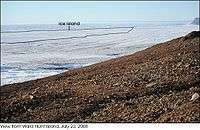Ward Hunt Island
 | |
 | |
| Geography | |
|---|---|
| Location | Northern Canada |
| Coordinates | 83°04′47″N 074°08′17″W / 83.07972°N 74.13806°WCoordinates: 83°04′47″N 074°08′17″W / 83.07972°N 74.13806°W |
| Archipelago | Queen Elizabeth Islands |
| Area | 13.9 km2 (5.4 sq mi) |
| Highest elevation | 415 m (1,362 ft) |
| Highest point | Walker Hill |
| Administration | |
|
Canada | |
| Territory | Nunavut |
| Region | Qikiqtaaluk |
| Demographics | |
| Population | Uninhabited |
Ward Hunt Island is a small, uninhabited island in the Arctic Ocean, off the north coast of Ellesmere Island. Its northern cape is one of the northernmost elements of land in Canada. Only a 17 km stretch of northern coast of Ellesmere Island around Cape Columbia is more northerly. The island is 6.5 km (4.0 mi) long, east to west, and 3.3 km (2.1 mi) wide. The first known sighting was in 1876 by Pelham Aldrich, a lieutenant with the George Nares expedition, and named for George Ward Hunt, First Lord of the Admiralty at the time (1874-1877).
History
Ward Hunt Island was briefly used as a weather station during the International Geophysical Year of 1957-58, and since then it has been used as the starting point for a number of attempts to reach the North Pole, beginning with Ralph Plaisted in 1968. There is an airstrip,and a building on the north shore of the island.
On July 29, 2008, a giant chunk of ice broke away from the shelf on Ward Hunt Island. The new ice island had an area of 35.9 km2 (13.9 sq mi). It was the largest fracture of its kind since the nearby Ayles Ice Shelf—which measured 66 km2 (25 sq mi)—broke away in 2005.[1]
In 1959, an American geologist, Paul T. Walker, put a note in a bottle and built a cairn over it near a glacier 800 km (500 mi) north of Grise Fiord, Nunavut. The note stated that the cairn was 1.2 m (3 ft 11 in) in front of a glacier, and left instructions to measure the distance again when the note was found. Researchers from Laval University found it in the summer of 2013. The distance by then was 101.5 m (333 ft). At the time, few scientists were expecting glaciers to retreat.[2]
In July 2016, a team of scientists with the Canadian Armed Forces while conducting a site visit of Eureka, Tanquary Fiord, and Ward Hunt Island found a cairn erected in 1975 by then Prime Minister, Pierre Trudeau, who had been accompanied by two of his sons, Justin Trudeau and Alexandre Trudeau. A picture of the plaque was presented to current Prime Minister Justin Trudeau by Defence Minister Harjit Sajjan on behalf of the Canadian Armed Forces.[3]
References
- ↑ Arctic ice shelf collapse poses risk: expert
- ↑ "1959 message in a bottle a clue to glacier melt". CBC News. 16 December 2013. Retrieved 19 December 2013.
- ↑ McKie, David (4 April 2017). "Discovery recalls Justin Trudeau's 1st visit to High Arctic — as a 3-year-old". CBC News. Retrieved 5 April 2017.
- Nares, George (1878). Narrative of a Voyage to the Polar Sea in H.M. Ships 'Alert' and 'Discovery'. London: Sampson Low, Marston, Searle, & Rivington.
External links
- The Bachmann map of Ward Hunt Island 1:25000
- Ward Hunt Island in the Atlas of Canada - Toporama; Natural Resources Canada